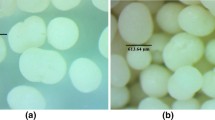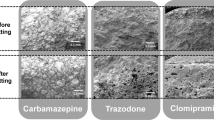Abstract
The objective of this study was to modify the release of two drugs having different solubility in a combined matrix tablet as a fixed-dose combination for extended release. Propranolol HCl (freely soluble) and carbamazepine (very slightly soluble) were used as model drugs, water-soluble hydroxypropyl methylcellulose (HPMC) and water-insoluble ethylcellulose (EC) were used as matrix-forming polymers. Tablets were prepared by direct compression of powder blends, or propranolol HCl was first granulated with one of the matrix-forming polymers (1:1) followed by compression with carbamazepine and matrix former. Propranolol HCl release from directly compressed tablets was faster than carbamazepine because of its higher solubility. The release of both drugs was fast when HPMC-propranolol HCl granules were compressed with carbamazepine into EC matrix tablet. Conversely, the release of both drugs was decreased when HPMC-propranolol HCl granules and carbamazepine were compressed into HPMC matrices. The desired release of both drugs was approached when EC-propranolol HCl granules were compressed with carbamazepine into HPMC matrix. Erosion of the HPMC matrix and, therefore, drug release were adjusted by varying the molecular weight of HPMC. A burst release of propranolol HCl decreased when it was granulated with EC in a fluidized bed coater followed by compression with carbamazepine into HPMC matrix.









Similar content being viewed by others
References
Gradman AH, Basile JN, Carter BL, Bakris GL, Materson BJ, Black HR, et al. Combination therapy in hypertension. J Am Soc Hypertens. 2010;4:90–8.
Reynolds JK. Fixed-dose combination of sitagliptin and metformin for the treatment of type 2 diabetes. Diabetes Metab Syndr Obes Dove Press. 2009;2:127–34.
Curatolo M, Sveticic G. Drug combinations in pain treatment: a review of the published evidence and a method for finding the optimal combination. Best Pract Res Clin Anaesthesiol. 2002;16:507–19.
Albanna AS, Smith BM, Cowan D, Menzies D. Fixed-dose combination antituberculosis therapy: a systematic review and meta-analysis. Eur Respir J. 2013;42:721–32.
Tallarida RJ. An overview of drug combination analysis with isobolograms. J Pharmacol Exp Ther. 2006;319:1–7.
Saeidipour F, Mansourpour Z, Mortazavian E, Rafiee-Tehrani N, Rafiee-Tehrani M. New comprehensive mathematical model for HPMC-MCC based matrices to design oral controlled release systems. Eur J Pharm Biopharm. 2017;121:61–72.
Cai X, Luan Y, Dong Q, Shao W, Li Z, Zhao Z. Sustained release of 5-fluorouracil by incorporation into sodium carboxymethylcellulose sub-micron fibers. Int J Pharm. 2011;419:240–6.
Tapia-Albarran M, Villafuerte-Robles L. Assay of amoxicillin sustained release from matrix tablets containing different proportions of Carbopol 971P NF. Int J Pharm. 2004;273:121–7.
Casettari L, Bonacucina G, Cespi M, Perinelli DR, Micheli M, Cacciatore I, et al. Effect of manufacturing temperature and molecular weights on compression, mechanical and dissolution properties of PEO matrix tablets. J Drug Deliv Sci Technol Elsevier. 2016;32:236–40.
Lazzari A, Kleinebudde P, Knop K. Xanthan gum as a rate-controlling polymer for the development of alcohol resistant matrix tablets and mini-tablets. Int J Pharm. 2018;536:440–9.
Song SH, Chae BR, Il SS, Yeom DW, Son HY, Kim JH, et al. Formulation of controlled-release pelubiprofen tablet using Kollidon ® SR. Int J Pharm. 2016;511:864–75.
Ali R. Ammonio methacrylate copolymer as a carrier for water-insoluble drug, preparation and characterization of an oral controlled-release matrix tablet. J Drug Deliv Sci Technol. 2017;41:7–12.
Katikaneni PR, Upadrashta SM, Neau SH, Mitra AK. Ethylcellulose matrix controlled release tablets of a water-soluble drug. Int J Pharm Elsevier. 1995;123:119–25.
Tahara K, Yamamoto K, Nishihata T. Overall mechanism behind matrix sustained release (SR) tablets prepared with hydroxypropyl methylcellulose 2910. J Control Release. 1995;35:59–66.
Zuleger S, Lippold BC. Polymer particle erosion controlling drug release. I. Factors influencing drug release and characterization of the release mechanism. Int J Pharm. 2001;217:139–52.
Maderuelo C, Zarzuelo A, Lanao JM. Critical factors in the release of drugs from sustained release hydrophilic matrices. J Control Release. 2011;154:2–19.
Viridén A, Larsson A, Wittgren B. The effect of substitution pattern of HPMC on polymer release from matrix tablets. Int J Pharm. 2010;389:147–56.
Gao P, Skoug JW, Nixon PR, Ju TR, Stemm NL, Sung KC. Swelling of hydroxypropyl methylcellulose matrix tablets. 2. Mechanistic study of the influence of formulation variables on matrix performance and drug release. J Pharm Sci. 1996;85:732–40.
Viridén A, Abrahmsén-Alami S, Wittgren B, Larsson A. Release of theophylline and carbamazepine from matrix tablets – consequences of HPMC chemical heterogeneity. Eur J Pharm Biopharm. 2011;78:470–9.
Viridén A, Wittgren B, Larsson A. The consequence of the chemical composition of HPMC in matrix tablets on the release behaviour of model drug substances having different solubility. Eur J Pharm Biopharm. 2011;77:99–110.
Zuleger S, Fassihi R, Lippold BC. Polymer particle erosion controlling drug release. II. Swelling investigations to clarify the release mechanism. Int J Pharm. 2002;247:23–37.
Grund J, Koerber M, Walther M, Bodmeier R. The effect of polymer properties on direct compression and drug release from water-insoluble controlled release matrix tablets. Int J Pharm. 2014;469:94–101.
Hiremath PS, Saha RN. Oral matrix tablet formulations for concomitant controlled release of anti-tubercular drugs: design and in vitro evaluations. Int J Pharm. 2008;362:118–25.
Neau SH, Howard MA, Claudius JS, Howard DR. The effect of the aqueous solubility of xanthine derivatives on the release mechanism from ethylcellulose matrix tablets. Int J Pharm. 1999;179:97–105.
Siepmann F, Karrout Y, Gehrke M, Penz FK, Siepmann J. Limited drug solubility can be decisive even for freely soluble drugs in highly swollen matrix tablets. Int J Pharm. 2017;526:280–90.
Badshah A, Subhan F, Rauf K. Controlled release matrix tablets of olanzapine: influence of polymers on the in vitro release and bioavailability. AAPS PharmSciTech. 2010;11:1397–404.
Li L, Li J, Si S, Wang L, Shi C, Sun Y, et al. Effect of formulation variables on in vitro release of a water-soluble drug from chitosan–sodium alginate matrix tablets. Asian J Pharm Sci Elsevier. 2015;10:314–21.
Author information
Authors and Affiliations
Corresponding author
Additional information
Publisher’s Note
Springer Nature remains neutral with regard to jurisdictional claims in published maps and institutional affiliations.
Rights and permissions
About this article
Cite this article
Chaerunisaa, A.Y., Ali, R. & Dashevskiy, A. Release Adjustment of Two Drugs with Different Solubility Combined in a Matrix Tablet. AAPS PharmSciTech 20, 142 (2019). https://doi.org/10.1208/s12249-019-1294-2
Received:
Accepted:
Published:
DOI: https://doi.org/10.1208/s12249-019-1294-2




